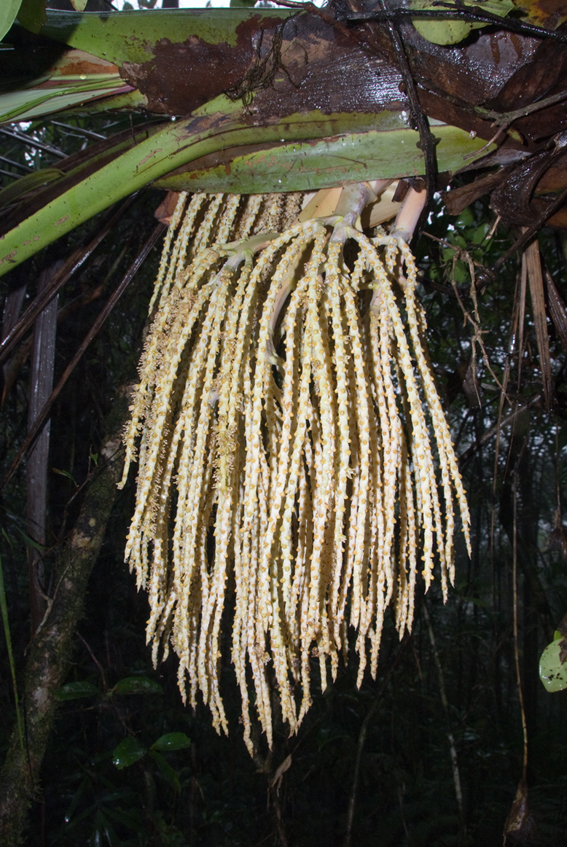- Acanthophoenix
- Acrocomia
- Actinokentia
- Actinorhytis
- Adonidia
- Aiphanes
- Allagoptera
- Ammandra
- Aphandra
- Archontophoenix
- Areca
- Arenga
- Asterogyne
- Astrocaryum
- Attalea
- Bactris
- Balaka
- Barcella
- Basselinia
- Beccariophoenix
- Bismarckia
- Borassodendron
- Borassus
- Brassiophoenix
- Burretiokentia
- Butia
- Calamus
- Calyptrocalyx
- Calyptrogyne
- Calyptronoma
- Carpentaria
- Carpoxylon
- Caryota
- Ceratolobus
- Ceroxylon
- Chamaedorea
- Chamaerops
- Chambeyronia
- Chelyocarpus
- Chuniophoenix
- Clinosperma
- Coccothrinax
- Cocos
- Corypha
- Cryosophila
- Cyphokentia
- Cyphophoenix
- Cyphosperma
- Daemonorops
- Deckenia
- Desmoncus
- Dictyocaryum
- Drymophloeus
- Elaeis
- Eleiodoxa
- Eremospatha
- Eugeissona
- Euterpe
- Gaussia
- Geonoma
- Guihaia
- Hedyscepe
- Hemithrinax
- Howea
- Hyophorbe
- Hyospathe
- Hyphaene
- Iriartea
- Iriartella
- Itaya
- Jailoloa
- Johannesteijsmannia
- Juania
- Jubaea
- Jubaeopsis
- Kentiopsis
- Kerriodoxa
- Korthalsia
- Laccospadix
- Laccosperma
- Lanonia
- Latania
- Lemurophoenix
- Leopoldinia
- Lepidocaryum
- Lepidorrhachis
- Leucothrinax
- Licuala
- Linospadix
- Livistona
- Lodoicea
- Lytocaryum
- Manicaria
- Manjekia
- Marojejya
- Masoala
- Mauritia
- Mauritiella
- Maxburretia
- Medemia
- Metroxylon
- Myrialepis
- Nannorrhops
- Nenga
- Neonicholsonia
- Neoveitchia
- Nephrosperma
- Normanbya
- Nypa
- Oenocarpus
- Oncocalamus
- Oncosperma
- Orania
- Oraniopsis
- Parajubaea
- Pelagodoxa
- Phoenicophorium
- Phoenix
- Pholidocarpus
- Pholidostachys
- Physokentia
- Phytelephas
- Pigafetta
- Pinanga
- Plectocomia
- Plectocomiopsis
- Podococcus
- Pogonotium
- Ponapea
- Prestoea
- Pseudophoenix
- Ptychococcus
- Ptychosperma
- Raphia
- Ravenea
- Reinhardtia
- Retispatha
- Rhapidophyllum
- Rhapis
- Rhopalostylis
- Roscheria
- Roystonea
- Sabal
- Sabinaria
- Salacca
- Saribus
- Satakentia
- Satranala
- Schippia
- Sclerosperma
- Socratea
- Solfia
- Sommieria
- Syagrus
- Synechanthus
- Tahina
- Tectiphiala
- Thrinax
- Trachycarpus
- Trithrinax
- Veitchia
- Verschaffeltia
- Voanioala
- Wallaceodoxa
- Wallichia
- Welfia
- Wendlandiella
- Wettinia
- Wodyetia
- Zombia
- x Jubautia splendens
- ?? Acoelorrhaphe
- ?? Bentinckia
- ?? Brahea
- ?? Clinostigma
- ?? Colpothrinax
- ?? Copernicia
- ?? Cyrtostachys
- ?? Dictyosperma
- ?? Dransfieldia
- ?? Heterospathe
- ?? Hydriastele
- ?? Iguanura
- ?? Incertae sedis & excluded names
- ?? Loxococcus
- ?? Micronoma
- ?? Paripon
- ?? Pritchardia
- ?? Rhopaloblaste
- ?? Serenoa
- ?? Washingtonia

Introduction
- This species has not been collected for almost fifty years, and the material is rather poor. This is another mystery, resembling D. bejofo and D. canaliculata. (Dransfield, J. & Beentje, H. 1995: The Palms of Madagascar)A
Distribution
Only known from the Marojejy area and Betampona. (Dransfield, J. & Beentje, H. 1995: The Palms of Madagascar)A
Discussion
- The following data from the protologue do not appear on the type label: found at 100 m altitude. This species resembles both D. bejofo and D. canaliculata but is distinct in the smaller and thinner trunk, the more branched inflorescence and the much smaller fruit. (Dransfield, J. & Beentje, H. 1995: The Palms of Madagascar)A
Biology And Ecology
- Moist lowland forest; 450 m (fide Cours). (Dransfield, J. & Beentje, H. 1995: The Palms of Madagascar)A
Conservation
- ?Extinct; not seen since 1949. (Dransfield, J. & Beentje, H. 1995: The Palms of Madagascar)A
Common Name
- Lafaza (Betsimisaraka). (Dransfield, J. & Beentje, H. 1995: The Palms of Madagascar)A
Uses
- Leaves used in thatching. (Dransfield, J. & Beentje, H. 1995: The Palms of Madagascar)A
Description
- Solitary palm. TRUNK 8-15 m high, cylindrical, 8-15 cm diam. LEAVES: sheath medium brown with a dense layer of wax, the young sheath bright pink, without ligules or auricles, distally with medium-sized laciniate scales; petiole c. 35 cm long, waxy, with scattered scales; rachis in mid-leaf 1.4-1.8 cm wide, keeled, with scattered scales, slightly waxy; leaflets in groups of 4-6, the group interval > 6 cm, the leaflet interval 0.5-1 cm, "hanging towards the middle" (Perrier); proximal 82-86 x 2.5-3.2 cm, median 55-92 x 2.3-2.9 cm, distal 13-39 x 0.3-2 cm, adaxially dark green, abaxially glaucous, with sparse large ramenta (6-10 mm long) on the proximal midrib, with minute reddish scales scattered over the minor veins, main vein 1, with slightly thickened margins, apex unequally attenuate. INFLORESCENCE interfoliar, branched to 3 orders (or more); prophyll coriaceous; peduncular bract coriaceous, deciduous, with a rather long beak; first order branch seen with secondary rachis of 6-20 cm, proximally 1-3 x 0.5-1.3 cm, glabrous, with 7-12 second order branches; rachis bracts up to 12 mm long; rachillae 16-30 cm long, 3-4.5 mm diam., with distant triads in shallow pits; rachilla bracts proud, rounded to acute. STAMINATE FLOWERS not seen. PISTILLATE FLOWERS not seen at anthesis; in the fruit the sepals are 3.7-4.1 x 3.9-4.7 mm (the outermost largest), obtuse, with membranous margins; petals 5-6 x 3.9-4.7 mm, the innermost largest; staminodes 0.5-1.1 mm, thin and flat. FRUIT ellipsoid, 16-20 x 8.5-12.5 mm, rounded at base and apex, with sub-basal stigmatic remains (with a ridge to the stalk); endocarp fibrous, with slightly anasto-mosing fibres. SEED ellipsoid, 12-13 x 5-6 mm, pointed at the base, rounded at the apex, attached to the spot corresponding to the stigmatic remnant on the outside; endosperm deeply ruminate, the ruminations reaching the middle. (Dransfield, J. & Beentje, H. 1995: The Palms of Madagascar)A
Materials Examined
- Andapa: Mt Mainampango, Amtalavanio, Jan. 1949 (fr.), Cours 3234 (K, P, TAN). Toamasina: Betampona, Dec. 1925 (fr.), Perrier 17474 (P, type). (Dransfield, J. & Beentje, H. 1995: The Palms of Madagascar)A
- Log in to post comments

